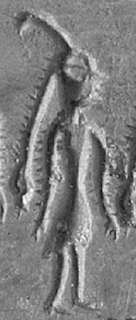Here is another "seal with a narrative scene", one of many made by people of the Indus Valley civilisation between 2200BC and 1900BC. The problem is, no one has a clue what the "narrative" is about. So let's see if I can shed any light on this mysterious "narrative scene"
This seal is rom Mohenjo-daro. The description of the scene is: "The horned image is standing amid a sacred fig or pipal tree, and a second horned image is kneeling in front of the tree, presenting an offering of a human head on a short stool"...
The interpretation of the scene is: "The standing figure is probably a deity while the kneeling figure could be a shaman or devotee"...Nothing about the tree, nothing abut the animal, nothing about the weird marching impish figures...No wonder we have no idea what's going on here
Ok. Let's start with the the climate in the area where this seal was made. We can see that the year consists of winter and spring with a little bit of precipitation, a summer with a lot of precipitation, and two dry part, Apr-May and Oct-Nov...
This two little dry periods are very very interesting. Why? Because Oct-Nov is when you sow grain in Indus Valley, and Apr-May is when you harvest grain in Indus Valley...For a civilisation dependent on grain farming, like the Indus Valley Civilisation, these are important dates...
So let's have a look at the seal, and check if the tree, the animal and the imps have anything to do with the grain farming agricultural year...(Spoiler: they all do)
The tree is the "sacred fig".
It flowers in Nov-Dec (during grain sowing) it's leaves fall off in Mar-Apr and regrow in Apri-May (during grain harvest) and the fruit ripens in May-Jun (beginning of monsoon)...Interesting...
Is the deity standing in the tree? Or is the deity "growing out of the tree"? Or is the deity actually the tree?
I don't know. But there is another deity which was depicted standing in a tree, growing out of a tree, being the tree at the same time. And not just any tree. Fig tree.
I think that the fig tree deity from Indus Valley is a goddess too. A goddess associated with life giving Indus river. Just like Hathor was associated with life giving Nile river. Both goddesses also associated with a fig that ripens when monsoon that feeds her river arrives...
The same animal depicted on this Indus Valley Civilisation "Narative seal"
In "Conservation and status of markhor (capra falconeri) in the northen parts of north west frontier province, Pakistan" we can read that Markhor goats mating season in Indus Valley is Oct-Dec. And that the baby goats are born Apr-Jun.
This would make a lot of sense from the animal calendar marker point of view. Oct/Nov is the beginning of the Rabi, dry season in Pakistan. And the time when grain is sown. And Apr/May is the end of the Rabi, dry season. And the time when grain is harvested. Just before the beginning of the monsoon...I talked about this in my post "Kharif and Rabi season".,..
But actually, it could be better than this...The animal on the seal could be a "mythical" composite animal.
It has a head of a Markhor goat, (possibly) neck of an Indian tiger although these stripes could just be the long Markhor neck hairs, (possibly) body of an Indian rhino although it could just be a body of a bull and (possibly) legs of a bull although they could just be legs of a rhino...
WTF???
Well, look at this:
In "Conservation and status of markhor (capra falconeri) in the northen parts of north west frontier province, Pakistan" we can read that Markhor goats mating season in Indus Valley is Oct-Dec.
On the "Wild life protection society of India" website page "The Indian Tiger - Quick Facts" we can read that "Although tigers mate and produce cubs throughout the year in India, peak breeding activity is in winter and early summer." Now in India, the seasons are as follows:
Winter: December to February.
Summer or pre-monsoon season: March to May.
Monsoon or rainy season: June to September.
Post-monsoon or autumn season: October to November.
Which means that Indian tigers mate between December and March
In the "Social and Reproductive Behaviour of Great Indian One-horned Rhino, Rhinoceros unicornis in Dudhwa National Park, U.P., India" we can read that "Indian rhinos prefer to breed between the months of March to June"
And Apr-May is the time when Eurasian wild cattle, Aurochs, started calving. These guys...I talked about this in my post "Ram and bull"...
Also depicted on Indus Valley seals...You can see why I am not sure about necks bodies and legs...
So if we put all these animals, and the beginnings of their mating or birthing periods, together we get our mythical animal:
Head: Markhor goat, start mating Oct/Nov
Neck: Indian tiger, start mating Dec/Jan
Body: Indian rhino, start mating Mar/Apr
Legs: Aurochs, start calving Apr/May
Put together, the time periods these animal calendar markers mark, we get a complex animal calendar marker, which marks the period between the planting of the grain and harvesting of the grain...Rabi season...Just like the Markhor goat alone with its mating-birthing...
Do we have any other indication on the seal that this could be right? Well yes. So what about the imps?
Well many people have already suggested that these are "7 sisters" or "7 mothers", the Pleiades...Interestingly, around 2000BC the evening rising of Pleiades was Oct-Nov (grain sowing) and morning rising of Pleiades was Apr-May (grain harvest)...
So, the same period...
Now what's the story with the so called "bangles" worn by the imps and the deity? Are they bangles at all?
You know what else can be represented by 7 grain imps with what looks like crescent moons coming out of their heads?
The time between the sowing and harvesting of grain. Oct/Nov - Apr/May...
So these could be these 7 grain growing months??? It all fits...
During which time you open 7 sealed grain storage pithos jars...
7 seals...Have you seen this article about "7 seals"?
So...We have:
1. Sacred fig flowering and leaf regrowth + ripening
2. Markhor goat mating and birthing
3. Pleiades evening and morning rising
All marking the grain sowing and grain harvest + monsoon
All on one seal, all neatly arranged into a "narrative scene", whose narrative we can hopefully now understand a bit better. What do you think?
To read more about ancient animal and plant calendar markers, start here…then check the rest of the blog posts related to animal calendar markers I still didn't add to this page, and finally check my twitter threads I still didn't convert to blog post...I am 9 months behind now...




















Great post. But the 2nd and 3rd pictures are not sacred figs, but redbud https://www.shutterstock.com/image-photo/single-fresh-redbud-leaf-cordate-isolated-324232172 and sea grape https://www.shutterstock.com/image-photo/seagrape-coccoloba-uvifera-fruit-leaf-on-1201787485, trees which grow here around Miami Beach. Compare the leaf vein arrangement, all 3 differ.
ReplyDeleteThanks very much. The pics I originally used were labeled as sacred fig...I have changed the one with fruit. It took me an hour to make sure this one is correct. A lot of fake sacred fig fruit pics out there...I couldn't find one that I can be sure is he sacred fig flower...Mad...
DeleteHehe, lots of 'sacred fakes' on the internet too, but your site isn't one of them. Your sincere interest shows clearly. Glad you got the right pic. Many tropical rainforest trees like figs have 'drip-tip' leaves, their long points make rain flow off faster, washing dust & bird droppings off.
ReplyDeleteInteresting but please the rhino pictured is an African rhino so wrong species. Please update
ReplyDeleteThanks. I am not a rhino expert, so when the pic is entitled Indian rhino...Anyway, double checked now...
Delete